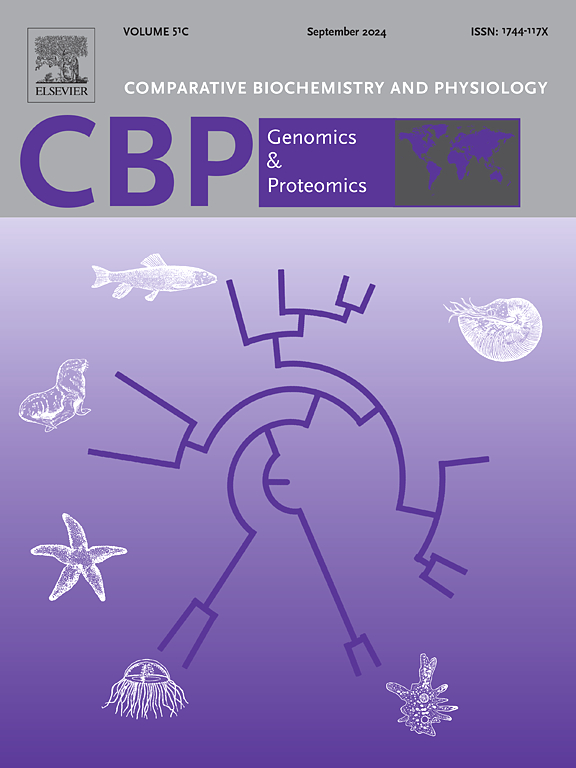暴露于镉改变了新热带鲶鱼肝脏蛋白质组的代谢途径
IF 2.2
2区 生物学
Q4 BIOCHEMISTRY & MOLECULAR BIOLOGY
Comparative Biochemistry and Physiology D-Genomics & Proteomics
Pub Date : 2025-06-06
DOI:10.1016/j.cbd.2025.101564
引用次数: 0
摘要
镉(Cd)是一种非必需金属,因其在生物体中具有生物放大和生物积累的潜力而闻名,引起了人们对水生环境和人类毒性影响的担忧。然而,镉的毒性作用在不同物种之间似乎是不同的,其毒性机制仍然知之甚少,特别是在本地新热带鱼类中。本研究旨在评估暴露于环境相关浓度Cd的雄性Rhamdia quelen肝脏的蛋白质组学变化。为此,在实验室条件下将鱼饲养在60 L的水箱中,并暴露于不同浓度的CdCl2: 0.1, 1, 10和100 μg/L中15天。鱼被麻醉,在安乐死后,它们的肝脏是随后使用UniProtKB数据库进行蛋白质组学分析的样本,这是最适合这个物种的。从最初的1366个表达蛋白中,有117个具有统计学意义,其中大多数属于暴露于10 μg/L的动物组。这些差异表达蛋白主要与能量产生、碳水化合物代谢、蛋白质合成和降解、免疫反应和解毒等代谢途径有关。尽管如此,10 μg/L的浓度表现出最明显的变化,并具有重要的生物学相关性,因为该浓度在淡水生态系统中经常检测到,并且可以影响几个代谢过程。本研究提供了Cd毒性作用机制的重要信息,突出了暴露后受影响的蛋白靶点。此外,该研究支持了与生态毒理学相关的本地物种蛋白质组学分析的标准化协议。本文章由计算机程序翻译,如有差异,请以英文原文为准。

Exposure to cadmium alters metabolic pathways in the hepatic proteome of a neotropical catfish
Cadmium (Cd) is a non-essential metal known for its potential to biomagnify and bioaccumulate in organisms, raising concerns about the toxic effects on aquatic environments and human beings. However, Cd toxicity effects seem variable across species, and its mechanisms of toxicity remain poorly understood, particularly in native Neotropical fish species. This study aimed to evaluate proteomic alterations in the livers of male Rhamdia quelen exposed to environmentally relevant concentrations of Cd. For this, fish were maintained in 60 L tanks under laboratory conditions and exposed to different CdCl2 concentrations: 0.1, 1, 10, and 100 μg/L for 15 days. Fish were anesthetized and after euthania their livers were samples for subsequent proteomic analysis using the UniProtKB database, which is most suitable for this species. From the initial 1366-expressed protein, 117 were statistically significant, with most belonging to the group of animals exposed to 10 μg/L. These differentially expressed proteins were mainly related to metabolic pathways concerning energy production, carbohydrate metabolism, protein synthesis and degradation, immune responses, and detoxification. Nonetheless, the concentration of 10 μg/L exhibited the most pronounced changes and holds major biological relevance, given that this concentration is commonly detected in freshwater ecosystems and can affect several metabolic processes. This study provides crucial information about the mechanism of Cd toxicity in the R. quelen catfish liver, highlighting protein targets affected after exposure. Furthermore, the study supports a protocol standardization for proteomic analysis in this native species with ecotoxicological relevance.
求助全文
通过发布文献求助,成功后即可免费获取论文全文。
去求助
来源期刊
CiteScore
5.10
自引率
3.30%
发文量
69
审稿时长
33 days
期刊介绍:
Comparative Biochemistry & Physiology (CBP) publishes papers in comparative, environmental and evolutionary physiology.
Part D: Genomics and Proteomics (CBPD), focuses on “omics” approaches to physiology, including comparative and functional genomics, metagenomics, transcriptomics, proteomics, metabolomics, and lipidomics. Most studies employ “omics” and/or system biology to test specific hypotheses about molecular and biochemical mechanisms underlying physiological responses to the environment. We encourage papers that address fundamental questions in comparative physiology and biochemistry rather than studies with a focus that is purely technical, methodological or descriptive in nature.

 求助内容:
求助内容: 应助结果提醒方式:
应助结果提醒方式:


